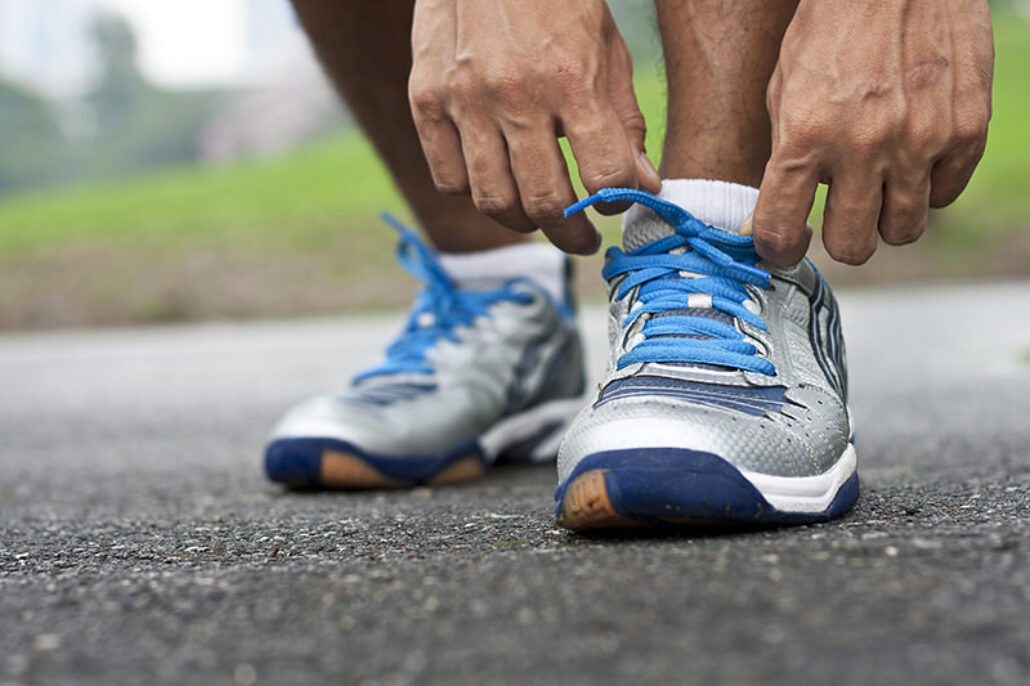When Summit patient and runner Julio Salazar was treated for a progressive running injury, he quickly learned that he was choosing his running shoes for all the wrong reasons. Physical therapist Sam Olson reviews the factors to consider when choosing the right running shoe.
Long night runs and weekend races are an important part of Julio Salazar’s life. He treasures the solitude and peace that he finds when he runs, and he uses his passion for running to raise awareness for another of his passions: educating his community about mental illness disorders and confronting stigmas about mental diseases.
When a long term running injury brought Julio to Summit, his treatment went beyond healing his injury. He also learned that running form—and his running shoes—play important roles in protecting himself from injury.
Julio walked into his first appointment at Summit wearing a new pair of expensive running shoes. “My doctor looked at my shoes and told me they were really bad for me,” Julio laughs. “I said, ‘What! They are super beautiful! I just bought them!’
“Shoes are a tool that can influence a runner’s form,” says Summit physical therapist Sam Olson. “Different runners respond differently to different footwear. There’s no “one size fits all” approach. Individual comfort is the best indicator that you are in the right shoe, but keep in mind that correct running form is much more important than your shoe. Your stride characteristics, muscle strength, muscular recruitment patters, and muscular coordination are the most important elements for injury-free running.”
“Currently, shoes are “prescribed” based on arch shape,” Sam notes. “This may not be the most accurate way to select shoes, or the most beneficial in preventing injuries.” The American College of Sports Medicine does advocate the following footwear recommendations:
- Look for a minimal heel-to-toe drop. There should be less than 6mm difference between the heel height and the forefoot height. If you are making a transition into a shoe with a lower “drop,” you’ll need more time to transition safely, and may want to seek knowledgeable instruction.
- Give preference to a shoe that is neutral, as opposed to a shoe with excessive stability elements.
- Choose a lightweight shoe. Men’s size nine shoes should weigh 10 oz or less. Women’s size eight shoes should weight no more than 8 oz.
- Make sure the toe box is wide enough to allow your toes to spread normally.
Julio learned that the toe box of his shoe was too wide for his foot. Summit taught him to make fit the first priority. “A number of local running stores will allow runners to take shoes home and run on a treadmill with them to test fit,” he says. “If the shoes don’t feel good, you can take them back. I used to go for looks and pretty colors.” Julio grins. “Now, I don’t care how my shoes look. I buy the running shoes that wraps around my foot and fits like it was made for me.”
“When you come to Summit Orthopedics to see a doctor or physical therapist who specializes in running and prevention of running injuries, we’ll give footwear recommendations based on your previous injury history, your body’s strengths and weaknesses, dynamic control, and your running stride characteristics,” says Sam. “We are happy to help guide you to the best shoe for you, and get you back to running at your highest potential.”
Summit Orthopedics offers personalized foot and ankle expertise
Our fellowship-trained foot and ankle physicians understand that your mobility depends on the health of your feet and ankles. If you have suffered an injury or are experiencing symptoms that make walking painful, our team of foot and ankle specialists can help with conservative treatment, seasoned surgical teams, and expert rehabilitation support. Summit Orthopedics specialists have the expertise to evaluate your discomfort and develop a plan to quickly and safely get you back on your feet and on your way.
Start your journey to optimal foot health. Find your foot and ankle expert, request an appointment online, or call us at (651) 968–5201 to schedule a consultation.
Summit has convenient locations across the Minneapolis-St. Paul metro area, serving Minnesota and western Wisconsin. We have state-of-the-art centers for comprehensive orthopedic care in Eagan, MN, Plymouth, MN, Vadnais Heights, MN, and Woodbury, MN, as well as additional community clinics throughout the metro and southern Minnesota.
More resources for you
- Are Your Shoes Dangerous To Your Foot Health?
- Ask Sam Olson: Should Running Shoes Be Based On Arch Shape?
- Ask Sam Olson: Does My Running Shoe Matter?

